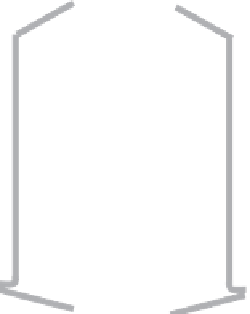Environmental Engineering Reference
In-Depth Information
figure 4.39 A thermostatic trap (shown in the open position).
boiling point lower than that of water (see Figure 4.39). The bellows con-
tracts when in contact with condensate and expands when steam is pres-
ent. If a heavy condensate load occurs, the bellows will remain in the
contracted state, allowing condensate to flow continuously. As steam
builds up, the bellows closes. Thus, at times the trap acts as a “continu-
ous flow” type, while at other times it acts
intermittently as it opens and closes to con-
densate and steam, or it may remain totally
closed (Bandes and Gorelick, 2000).
Key Point:
The thermostatic trap is designed to
operate at a definite temperature drop a certain
number of degrees below the saturated tem-
perature for the existing steam pressure.
A
float-and-thermostatic
trap is shown in Figure 4.40. It consists of a
ball float and a thermostatic bellows element. As condensate flows through
the body, the float rises and falls, opening the valve according to the flow
rate. The thermostatic element discharges air from the steam lines. They
are suitable for heavy and light loads and on high and low pressure, but
they are not recommended where water hammer is a possibility.
4.14.4.1 Trap Maintenance and Testing
Because they operate under constantly varying pressure and tem-
perature conditions, traps used in steam systems require maintenance.
Just as significant, because of these varying conditions, traps can fail.
When they do fail, most traps fail in the open mode, which may require
the boiler to work harder to perform a task which, in turn, can create
high backpressure to the condensate system. This reduces the discharge
capacities of some traps, which may be operating beyond their rating
and thus cause system inefficiency. A closed trap produces condensate




























